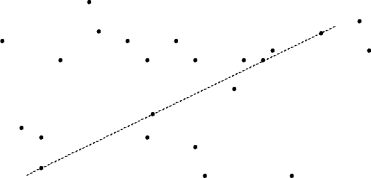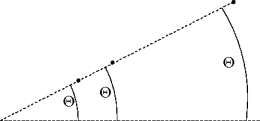A Problem
- Given a set of points on a plain

find a largest subset of collinear points.
What's a Solution?
- Writing down the problem practically describes the solution.
int main() cout << find-maximal-collinear-subset( read_points(std::cin)) - This is design by wishful thinking.
- But you're your own genii.
Are We Done?
- Are we done? Have we solved the problem?
- It depends: where are
read_points()andfind-maximal-collinear-subset()?- Oh, darn.
- But if they did exist, the problem's solved.
The Next Step
- There are now two problems to solve:
-
find-maximal-collinear-subset() -
read_points()
-
- There are more of them, but they're each simpler than the original problem.
Make A Wish
- Let's look at
find-maximal-collinear-subset(). - What's the problem?
- Given a set of planar points, find a largest collinear subset.
find-maximal-collinear-subset(pts) lcs = { } for each subset ss in pts if collinear(ss) and #ss > #lcs lcs = ss return lcs
Are We Done Now?
find-maximal-collinear-subset(pts)
lcs = { }
for each subset ss in pts
if collinear(ss) and #ss > #lcs
lcs = ss
return lcs
-
collinear()is a problem, as is generating subsets.-
collinear()is a solved math problem. - Generating subsets is an unsolved problem.
-
Subsets
- What do we know about subsets?
- S is a subset of S.
- { } is a subset of S.
- if S = {s} ∪ S', S' is a subset
of S.
- {1, 2, 3} = {1} ∪ {2, 3}
- #S' < #S
Generating Subsets
generate-subsets(s)
if s ≠ {}
for each e in s
s' = s - {e}
generate-subsets(s')
- But
find-maximal-collinear-subset()used a for loop.
Revising The Design
find-maximal-collinear-subset(pts, lcs)
if collinear(pts)
lcs = pts
else
for each e in pts
pts' = pts - {e}
generate-subsets(pts', lcs)
- This seems to be the end of our design.
- There are a few improvements available.
Pseudocode Design
- Hey! That's not C++!
- There's no reason to use C++ on paper.
- Pseudo-code's more productive.
- It does have translation costs.
- Make up your own language as you go along.
- Just remember you have to translate it.
- Too much freedom? Stick with simple subsets of a langauge you know.
Design
- Two main design problems: how to start, how to keep going.
- How to start - top-down design.
- Start from the problem, work towards a solution.
- You'll always have a problem to work on.
- Why bother if you're not going to pay attention to the problem?
Stepwise Refinement
- Stepwise refinement is how to keep going.
- Start with an abstract problem, end with a concrete problem.
- Each step adds detail to the problem.
- Solve the problem at each step.
- The step-to-step solution changes should be small.
Design via Refinement
- Top-down design starts with the problem.
- You'll always have a problem.
- The problem can provide a lot of guidance.
- Start small, step small.
- Abstract away almost all problem details.
- Re-introduce abstracted details one at a time.
- The solution changes in small, manageable steps.
Top-Down Design Advantages
- You always have a working system.
- The initial solution works, but isn't useful.
- Each step keeps a working solution, improves usefulness.
- Test each step, add tests between steps.
Top-Down Design Problems
- Abstraction is hard; some people don't get it.
- Usually your bosses, their bosses, and so on.
- Lots of decisions to make all the time.
- And you have to remember them. And you have to fix them.
- Sometimes it seems like it never ends.
- But, suddenly, it does.
- All of these things are skills you have to learn
What's the Problem?
- Input a point set,
output a maximal collinear subset. - That's it; that's the problem.
- How many points?
- Who cares? Worry about it later.
- What happens if the points aren't coplanar?
- Who cares? Worry about it later.
- How many points?
- Find and work on the essential details.
Abstraction
- Abstracting away almost all details leaves a simpler problem.
- "Abstracting" means "delaying", not "forgetting".
- The abstracted details are reintroduced one at a time.
Details
- What's a point set?
- I dunno. A data structure. An object. Whatever.
- It depends on what you want to do with it.
- How do I do point-set I-O?
- This is not - should not be - a big problem.
- These questions have to be answered.
- Just not right now; later.
Testing
- Your program should start out correct, and keep correct.
- Testing helps make sure that's the case.
- Develop a small set of tests along with your program.
- Test your program after every step.
- Shell programming or scripting languages and make are helpful.
Test Cases
- Simple tests do the trick.
- Start off with the empty test.
- As you fill in details, add more tests relevent to the details.
- Added point-set I-O? Add a test case consisting of one point.
- Added collinearity? Add a test case consisting of two points.
- When you discover an error, always add a test case exposing the error.
Collinearity Revisited
- Points are collinear when
- They lie on the same line, or
- They all have the same angular measure from the same axis.

The Next Solution
find maximal collinear subset(points)
max points = { }
for p1 in points
order points by increasing angle
scan for similar angles
similar angles mean collinear points
remember the biggest set
return max points
Other Design Techniques
- There are other approaches.
- Bottom-up design.
- Requires immense (or cliched) experience.
- Easy to be led astray.
- Object-oriented analysis.
- Enormous overhead.
- The design frequently becomes the problem.
- Bottom-up design.
Points to Remember
- Understand the problem.
- Consentrate on the most important parts of the problem.
- Once solved, move on to the next most important parts.
- Test every step of the way.